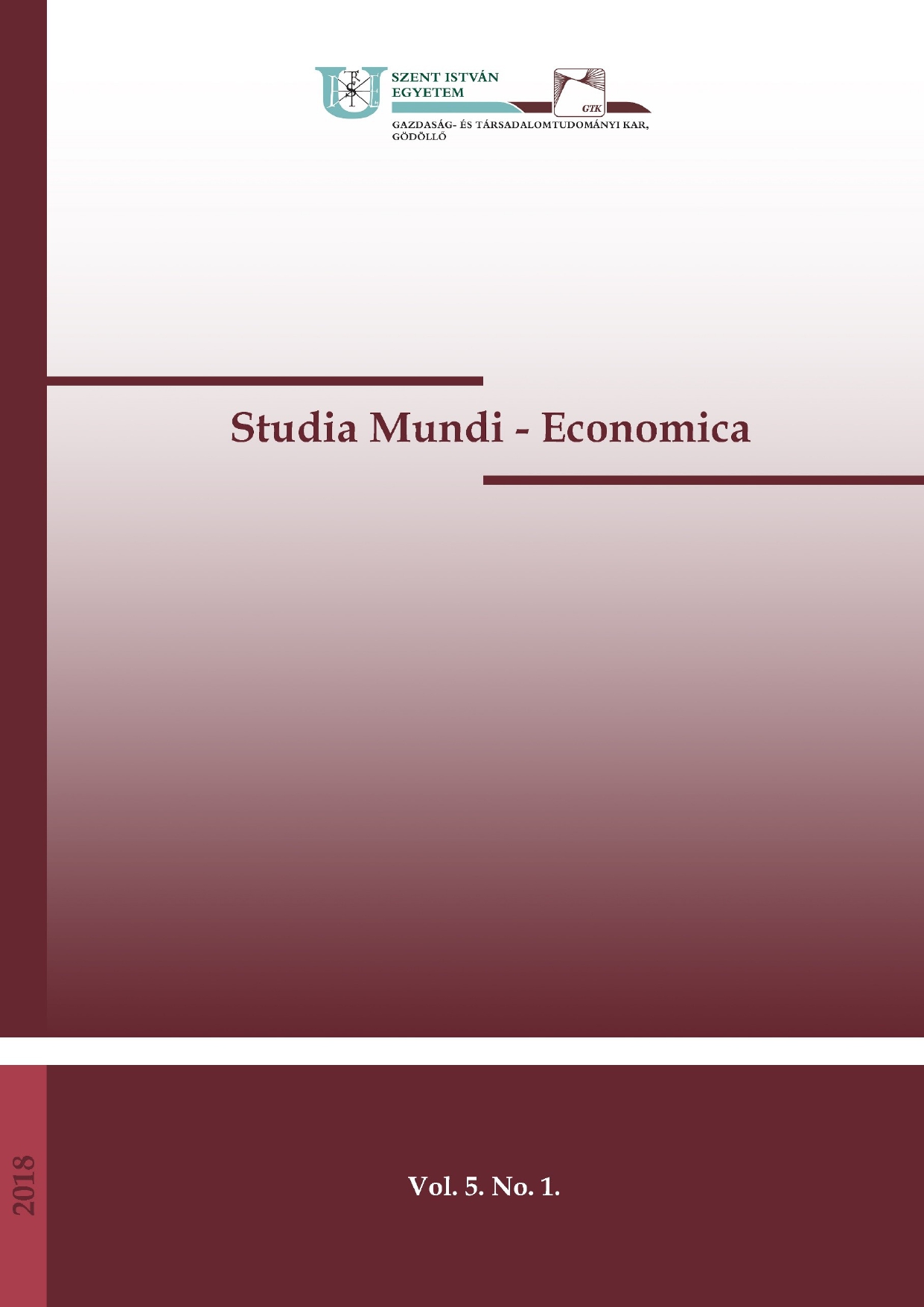The study of suburbanization processes in the area of Gyöngyös District
DOI:
https://doi.org/10.18531/Studia.Mundi.2018.05.01.45-58Keywords:
szuburbanizáció, migráció, Gyöngyösi járás, város-vidék kapcsolatok, vidékfejlesztésAbstract
In the last decades, suburbanization processes have also started in Hungary, as earlier in European metropolitan areas. Many of its effects were observed first and foremost in urban agglomeration of Budapest. As a consequence of the constant migration to the countryside, the suburban population increased. While the number of residents in the capital decreased. This process became more and more rapid in the 2000s in all the metropolitan agglomerations of the country.
Our study focuses on the environment of a small-medium sized town, Gyöngyös. The phenomena related to residential suburbanization were investigated in the area of Gyöngyös district. It was explored what were the drivers of migration to rural settlements from 2001 to nowadays. The suburbanisation index was calculated for this purpose for each settlements of the district except the central town. Based on the results of a residential questionnaire it was analysed the composition and motivational characteristics of the population involved in suburbanization
References
Andersson, K. (2005): Producers of Rural Goods and Services in Five European Countries: a comparative analysis of rural regions under urban pressure. Helsinki University, Helsinki.
Bajmócy P. (2003) Vidéki szuburbanizáció Magyarországon, PhD disszertáció, Szeged.
Bajmócy P. (2014): A szuburbanizáció két évtizede Magyarországon. In: Északmagyarországi stratégiai füzetek, 11. évf. 2. sz. pp. 6-18.
Bajmócy P. et. al (2012): Urbanizációs trendek a rendszerváltozás utáni Magyarországon. In: Pál V. (szerk.): A társadalomföldrajz globális és lokális kérdései. Szeged, pp. 95–111.
Boyle, P. – Halfacree, K. (1998): Migration into Rural Areas: Theories and Issues, Wiley, Chichester.
Cloke, P (1997): Country Backwater to Virtual Village? Rural Studies and ’The Cultural Turn’. Journal of Rural Studies 13(4), pp. 367-375.
Csatári B. (2004): A magyarországi vidékiségről, annak kritériumairól és krízisjelenségeiről. Területi Statisztika 44(6), pp. 532-543.
Csurgó B. (2013) Vidéken lakni és vidéken élni: A városból vidékre költözők hatása a vidék átalalkulására: a város környéki vidék. Argumentum Kiadó; MTA TK Szociológiai Intézet, Budapest. ISBN 978-963-446-700-7
Dudás R. (2013): A szuburbanizáció és a dezurbanizáció folyamatai Magyarországon az érintett települések önkormányzatainak szemszögéből. In. Településföldrajzi Tanulmányok 2013/1 pp. 20–32.
Elands, B. – Wiersum, F. (2001): Forestry and rural developlopment in Europe: an exploracion of socio-political discourse. Forest Policy and Economics, 3.
Enyedi Gy. (1972): A társadalom és földrajzi környezete. Földrajzi közlemények 20(4), pp. 293-301.
Enyedi Gy. (1988): A városnövekedés szakaszai, Akadémiai Kiadó, Budapest, 115 p.
Fielding, S. (1998): Indigeneity, Identity and locality: perspectives on Swaledale. In: Boyle–Halfacree (ed.) Migration into rural areas – Theories and Issues. John Wiley and Sons, pp. 151–165.
Gergely J. (2014): Településvezetés és szuburbanizáció. Tér és Társadalom. 28 (4), pp. 138-155.
Hardi T. (2002): Szuburbanizációs jelenségek Győr környékén. = Tér és Társadalom 16 (3), pp. 57-83.
Izsák É. (1999) A települési sorrend megváltozása a szuburbanizációs index alapján a budapesti agglomerációban In: Földrajzi Értesítő 1-2, pp. 83-92.
Kovács A. D. – Farkas J. Zs. – Perger É. (2015): A vidék fogalma, lehatárolása és új tipológiai kísérlete. Tér és Társadalom. 29 (1) pp. 11-34.
Lash, S. – Urry, J. (1994): Economies of Signs and Space. London, Sage.
Nagyné Demeter D.–Asztalos G. (2014): A mátrai tallér bevezetésének lehetőségei a Gyöngyösi kistérségben. In: Koncz G.-Nagyné Demeter D. (szerk.): Helyi erőforrások turisztikai hasznosítása a magyar-szlovák határrégióban. Károly Róbert Főiskola, pp. 93-112.
Phillips, M. (2005): People at the centre? The contested geographies of gentrification. In: Phillips, M. (szerk.) Contested worlds: an introduction to human geography. Ashgate: Aldershot, pp. 317–352.
Ravenstein, E. G. (1889): The laws of migration, In. Journal Royal Statistical Society, 52., pp. 241-301.
Savage, M. – Barlow, J. – Dickens, P. – Fielding, T. (1992): Property, Buerocracy and Culture: Middle-classformation in Contemporary Britain. London, Routledge.
Szakál F. (1999): Vidékfejlesztés vidékpolitika. Cikkek, tanulmányok. Válogatás az A Falu c. folyóiratban 1996-99 között megjelent tanulmányokból. A fenntartható mezőgazdaság és szerepe a vidéki térségek fejlődésében. Agroinform Kiadóház, Budapest, 326 p.
Szebényi A. (2016): A lakóhelyi szuburbanizáció területi-strukturális jellemzői Pécs környékén. Doktori értekezés. Pécsi Tudományegyetem, Pécs, 185 p.
Van Den Berg Leo et al. (1982): Urban Europe: A study of growth and decline, Oxford, Pergamon, 162 p.
Váradi M. M. (2008): Utak, elágazások – a közelmúlt falukutatásai, In: Kovács É. (szerk.) Közösségtanulmány. Módszertani jegyzet, PTE–BTK Kommunikáció és Médiatudományi Tanszék, Pécs, pp. 43–68.
Waldorf, B. S. (2006): A continuous multi-dimensional measure of rurality: Moving beyond threshold measures. Paper selected for the Annual Meetings of the Association of Agricultural Economics, Long Beach
Downloads
Published
Issue
Section
License
Copyright (c) 2018 Szűcs Antónia, Koncz Gábor

This work is licensed under a Creative Commons Attribution-NonCommercial-NoDerivatives 4.0 International License.
A folyóirat Open Access (Gold). Cikkeire a Creative Commons 4.0 standard licenc alábbi típusa vonatkozik: CC-BY-NC-ND-4.0. Ennek értelmében a mű szabadon másolható, terjeszthető, bemutatható és előadható, azonban nem használható fel kereskedelmi célokra (NC), továbbá nem módosítható és nem készíthető belőle átdolgozás, származékos mű (ND). A licenc alapján a szerző vagy a jogosult által meghatározott módon fel kell tüntetni a szerző nevét és a szerzői mű címét (BY).






